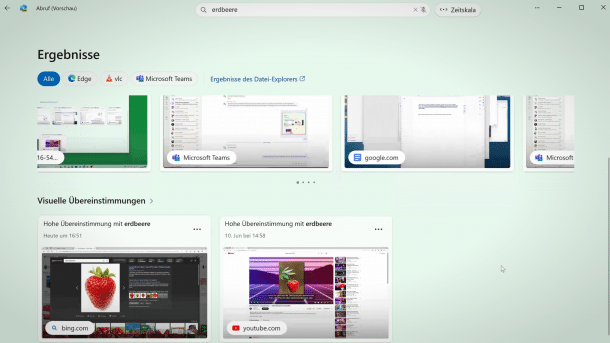Microsoft Recall comes with opt-in, more filters and encryption
Recall will no longer store health data, credit card numbers and other data. In addition, more encryption is used and opt-out is possible during Windows setup.

This is how Recall used to work: If you search for "strawberry", all screenshots with the term or corresponding image content appear.
(Image: c't 3003)
In October 2024 , Microsoft plans to offer the controversial Recall AI search function for Windows 11 again for Copilot+ PCs after a withdrawal – with extensive changes. The company has now announced this in an extensive blog post. In the very first sentence, it states that "AI is becoming more and more an integral part of Windows" – Consequently, Microsoft is not abandoning Recall, but is giving users more options to configure the function or switch it off completely.
According to the article, there should be a separate screen when installing Windows where you can switch off the regular saving of screenshots, the basis of Recall, completely. However, Microsoft makes the function quite appealing to users with the headline "Unlock your photographic memory with Recall" in this part of the Windows setup. The company mentions in passing that Recall can also be "completely removed" via the Control Panel after installing Windows.
Recall should not store any sensitive data
If you opt for Recall, the system should not store particularly sensitive data by default. Microsoft only explicitly mentions credit card data, ID numbers and passwords. To filter this information before the screenshot is taken, Recall uses the Purview system, which is already known from the Windows editions for public authorities and companies. The contents of private browser windows should never be saved. In another post, Microsoft names the supported browsers, including Chrome, Edge, Firefox, Opera and some Chromium-based programs. The blog post does not provide any information on content for adults.
It is also possible to retroactively delete content from the Recall screenshot catalog. According to the blog, this should be possible for programs, websites or a specific time period. All Recall data can also be removed. Microsoft emphasizes in its article, as well as in the aforementioned part of the Windows setup, that "you are always in control" and thus apparently wants to promote trust.
Videos by heise
Screenshots no longer freely accessible
After the screen recordings of Recall were saved unencrypted and as freely accessible JPEG files in the first version, Microsoft has changed this completely in the new version. The screenshots should now always be encrypted, and access to the recordings is only possible by confirming the user's identity via Windows Hello. The keys are stored in the computer's TPM. The underlying system, also for Recall, is VBS Enclave (Virtualization-based Security). This would make Recall as secure as the rest of Windows, for example when it comes to encrypted data or logging in. The enclaves are protected and encrypted areas in a PC's RAM, among other things.
Microsoft announced Recall in June 2024, but withdrew it again following heavy criticism. The function was to be delivered with the new Copilot+ PCs. In August, the company then said that Recall would not be offered again until October in a revised version, and only for voluntary participants in the Windows Insider Program. As Microsoft does not provide any other information in its current blog post, it can be assumed that this is still the case – so the devices with Copilot+ still do not have the full range of functions promised – if you want to use Recall.
(nie)